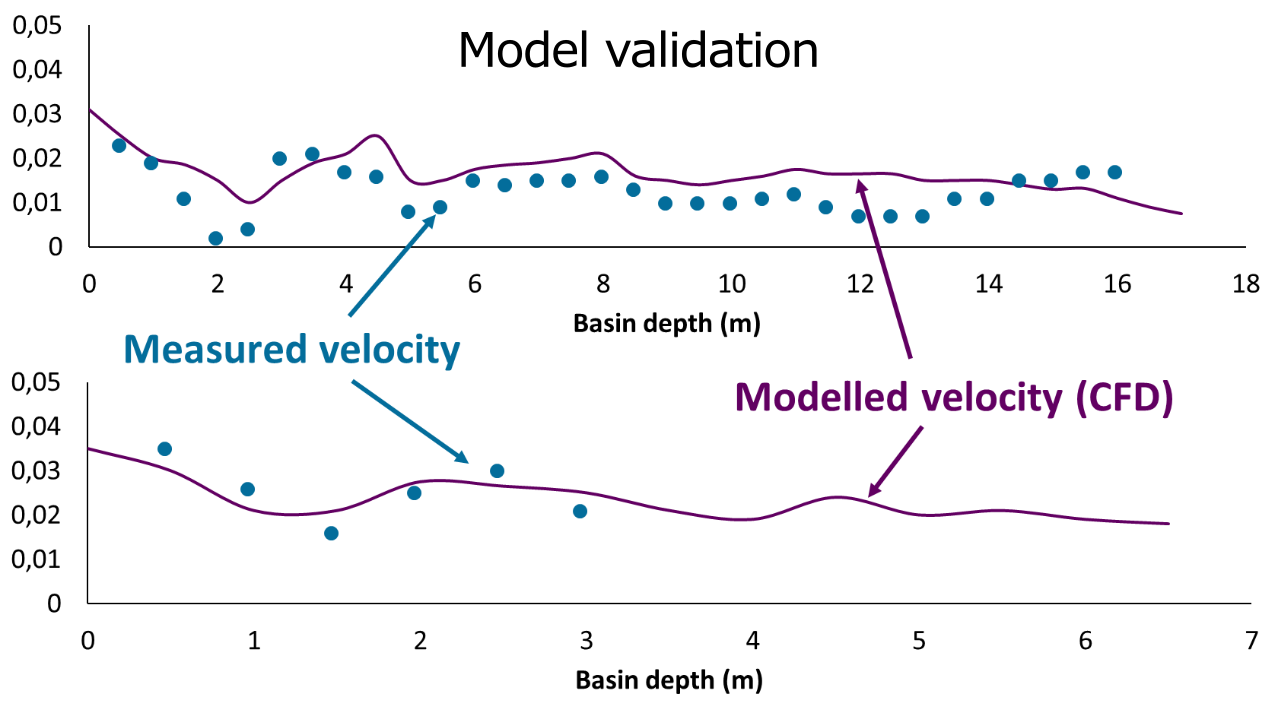3D CFD simulation of large drinking water basins and a plant-wide digital twin
Optimal design of inlet and aeration in drinking water storage basin using computational fluid dynamics (CFD) modelling. Aeration was taken into account. Multiphase CFD simulation of air and water. Shortcircuiting and dead zones avoided.
-mod_409.jpg)
Questions from the drinking water company
This project is an example of large scale 3D modelling and the development of a digital twin. Our client, a Dutch drinking water company, produces drinking and process water from the IJssel Lake. The source quality can vary throughout the year. Our client had the following questions:
- How well are the surface water storage basins mixed, and how to optimise the system?
- What are the best locations to introduce new streams in the basins?
- How do upstream IJssel Lake water quality fluctuations translate in downstream fluctuations potentially impacting the treatment operation (after travelling through the basins)?
- Can particles reach the intake to the treatment facilities? If yes, which, and how to minimise risk?
CFD modelling of the basins
We modelled both basins in 3D, realistically accounting for:
- Aeration (1 coarse bubble aerator in each basin)
- Wind
- Particle settling
- Introduction of salt rich streams (higher density)
- The basin specific geometry

-mod.jpeg)

We injected a virtual tracer and the CFD model visualised dead zones and shortcircuiting. Scenarios at different flow conditions and aeration switched on and off were run to assess optimal conditions.

Figure 1: The CFD model accurately predicted local velocities, as shown by comparing measured and simulated velocities
A plant-wide digital twin for dynamic modelling
The 3D CFD outcomes were translated into a fast dynamic plant model that could be used to quickly assess numerous 'what-if' scenarios (please ask us if you want to know how we do that). For example:
- How and when would increasing chloride concentrations in the IJssel Lake translate in downstream dynamics going to the treatment plant?
- What is the impact of increasing or decreasing certain operational flows?
Outcomes
- The location of the aeration could be optimised for better mixing
- The fast dynamic model derived from CFD results could be used to run numerous 'what-if' scenarios that led to better operational decisions. The new measures were succesfully implemented with the necessary confidence.
- Solids concentration in the treatment facility intake could be minimised by operational measures that were found using the model
- Aeration had a major impact on the mixing of the basins. Switching it off dramatically decreased mixing efficiency
- The CFD model was found to be highly accurate in terms of mixing prediction (validated at different levels)

Figure 2: The dynamic model (purple line) could predict reality (blue data points) very well. This model was used to run different 'what-if' scenarios to make better operational decisions.
Suggested Projects


Subscribe to our newsletter








